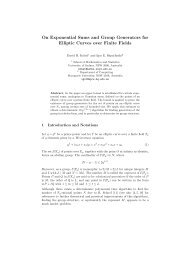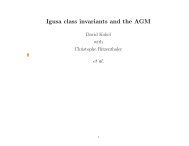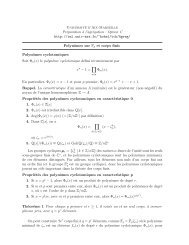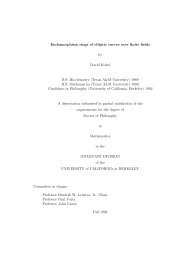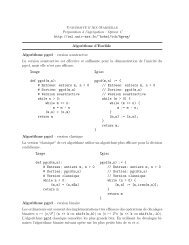Magma Cryptosystems - The University of Sydney
Magma Cryptosystems - The University of Sydney
Magma Cryptosystems - The University of Sydney
Create successful ePaper yourself
Turn your PDF publications into a flip-book with our unique Google optimized e-Paper software.
<strong>The</strong> <strong>University</strong> <strong>of</strong> <strong>Sydney</strong><br />
Math3024 Elementary Cryptography and Protocols<br />
Semester 1 Exercises for Week 3 2004<br />
Objectives: We review the facilities for cryptosystems in <strong>Magma</strong>, then investigate cryptanalytic<br />
methods for ciphertext. We will use these methods to crypanalyze ciphertext<br />
samples from the course web page.<br />
<strong>Magma</strong> <strong>Cryptosystems</strong><br />
A cryptosystem can be created in <strong>Magma</strong> with the following commands:<br />
> C := SubstitutionCryptosystem();<br />
> V := VigenereCryptosystem(7);<br />
> V;<br />
Vigenere cryptosystem<br />
<strong>The</strong> latter constructor (<strong>of</strong> the Vigenère cryptosystem) specifies a key length <strong>of</strong> 7 characters.<br />
Recall that the <strong>Magma</strong> type <strong>of</strong> a cryptosystem is Crypt, and that a cryptosystem<br />
key, <strong>of</strong> type CryptKey is viewed as an element <strong>of</strong> the cryptosystem. It specifies an particular<br />
enciphering map in the cryptosystem. A key can be created either by coercion (the<br />
! operator) <strong>of</strong> a valid keystring into the cryptosystem, or by the RandomKey function:<br />
> RandomKey(C);<br />
HYTIKQRWXUPZBJSCANEFODLVMG<br />
> K := V!"PRNXJAM";<br />
> K;<br />
PRNXJAM<br />
Finally we will need cryptographic text (plaintext and ciphertext). This will be <strong>of</strong><br />
type CryptTxt, and can be created by the Encoding and Enciphering functions. To<br />
extract the underlying string (<strong>of</strong> <strong>Magma</strong> type MonStgElt), use the function String.<br />
> M := "This is sample message text to be encoded.";<br />
> PT := Encoding(V,M);<br />
> PT;<br />
THISISSAMPLEMESSAGETEXTTOBEENCODED<br />
> CT := Enciphering(K,PT);<br />
IYVPRSEPDCINMQHJNDNTQMKGLKEQCTBAND<br />
> L := InverseKey(K);<br />
> Enciphering(L,CT);<br />
THISISSAMPLEMESSAGETEXTTOBEENCODED<br />
> Type($1);<br />
CryptTxt<br />
> String($1);<br />
THISISSAMPLEMESSAGETEXTTOBEENCODED<br />
> Type($1);<br />
MonStgElt
Cryptanalysis<br />
One important measure <strong>of</strong> a cryptographic text is the coincidence index. If we define<br />
p i to be the probability <strong>of</strong> occurrence <strong>of</strong> the i-th character <strong>of</strong> the codomain alphabet in<br />
a sample plaintext <strong>of</strong> ciphertext, then the coincidence index <strong>of</strong> the cryptosystem is the<br />
value:<br />
n∑<br />
p 2 i ,<br />
i=1<br />
where n is the size <strong>of</strong> the alphabet. Recall that the sum <strong>of</strong> all probabilities is 1, therefore<br />
the coincidence index is at most 1. <strong>The</strong> coincidence index is a measure <strong>of</strong> the probability<br />
that two randomly chosen characters are the same.<br />
To compute the coincidence index for a particular string <strong>of</strong> length N, we first compute<br />
the number <strong>of</strong> occurrences n i <strong>of</strong> each character in the alphabet. <strong>The</strong>n the probability <strong>of</strong><br />
equality for two randomly chosen characters from that string is given by<br />
∑ n<br />
i=1 n i(n i − 1)<br />
,<br />
N(N − 1)<br />
which we define to be the coincidence index <strong>of</strong> a string.<br />
For random text (uniformly distributed characters) in an alphabet <strong>of</strong> size 26, the coincidence<br />
index is approximately 0.0385. For English text, this value is 0.0661. <strong>The</strong>refore<br />
we should be able to pick out text which is a simple substitution or a transposition <strong>of</strong><br />
English text. Other languages will have an associated coincidence index, which<br />
Another important tool for cryptanalysis Kasiski test. This is useful for determining<br />
periodicity in ciphertext. Ciphertext <strong>of</strong> a Vigenère cipher has a period m such that for each<br />
fixed j the mi +j-th characters are given simple substitution <strong>of</strong> the corresponding mi +jth<br />
plaintext. If a frequently occurring pattern, such as THE is aligned at the same position<br />
with respect to this period, then the same three characters will appear in the ciphertext,<br />
at a distance which is an exact multiple <strong>of</strong> m. By looking for frequently occurring strings<br />
in the ciphertext, and measuring the most frequent divisors <strong>of</strong> the displacements <strong>of</strong> these<br />
strings, it is <strong>of</strong>ten possible to identify the period, hence to reduce to a simple substitution.<br />
<strong>The</strong> <strong>Magma</strong> crypto package functions<br />
Exercises<br />
CoincidenceIndex, Decimation, and FrequencyDistribution<br />
provide functionality for analysis <strong>of</strong> the ciphertexts in the exercises.<br />
1. For each <strong>of</strong> the cryptographic texts from the course web page, compute the coincidence<br />
index <strong>of</strong> the ciphertexts. Can you tell which come from simple substitution<br />
or transposition ciphers? How could you distinguish the two?<br />
2. For each <strong>of</strong> the cryptographic texts from the course web page, for various periods<br />
extract the substrings <strong>of</strong> im + j-th characters. For those which are not simple<br />
substitutions, can you identify a period?
3. For each <strong>of</strong> the ciphertexts which you have reduced to simple substitutions, consider<br />
the frequency distribution <strong>of</strong> the simple substitution texts. Now recover the keys<br />
and original plaintext.



